Karanji is a Maharashtrian sweet fried dumpling stuffed with a filling of coconut, wheat flour, poppy seeds, and nuts. These crispy treats are usually made during Holi, Diwali or Ganesh Chaturthi festival.
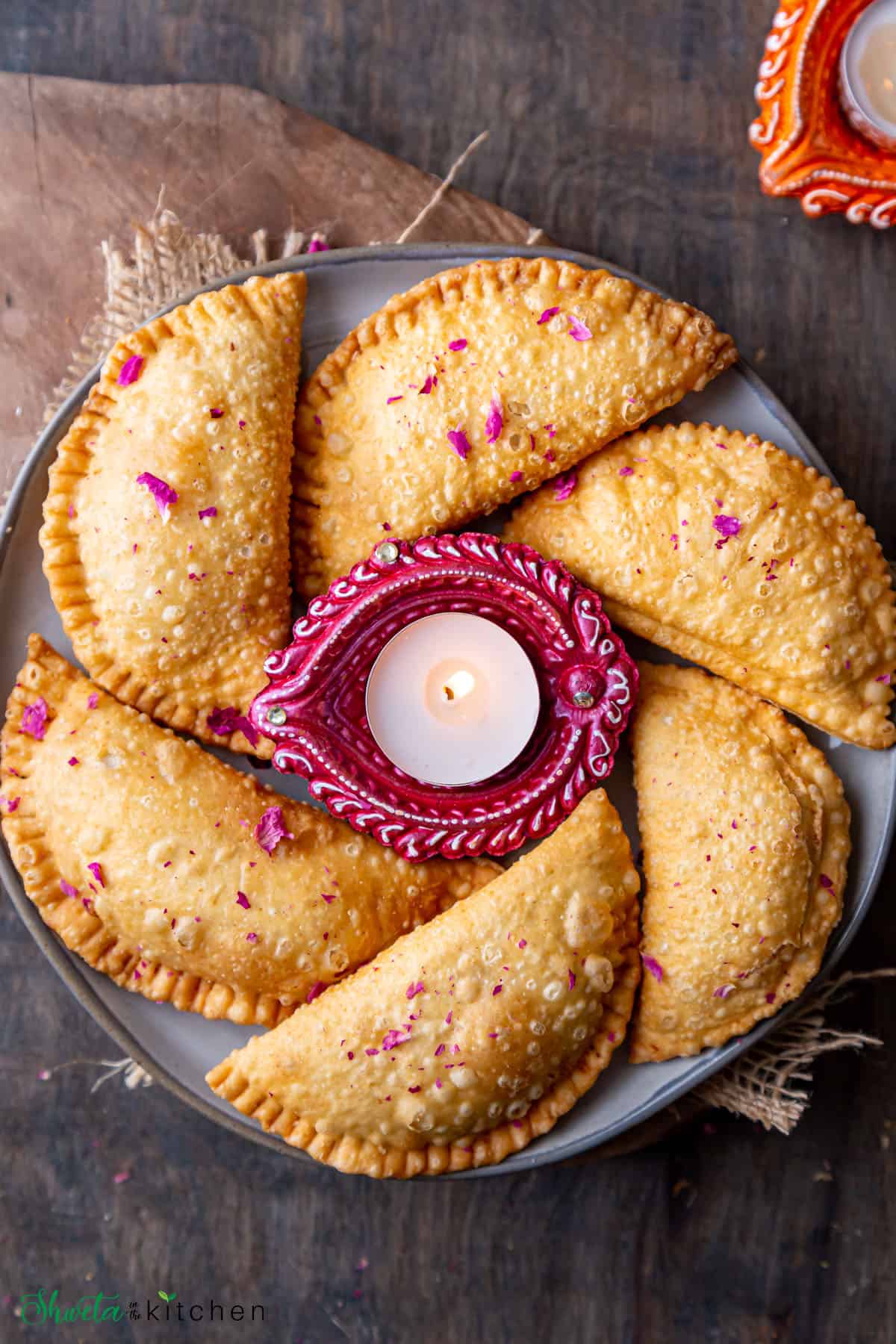
My Diwali Faral every year always has Coconut Karanji as they are my hubby's absolute favorite and now my girls love them too.
We love eating fresh hot karanjis while I make them. There is something so irresistible about that hot & crisp karanji that you just can't stop munching them!
These have a great shelf life when made with dry coconut filling so it's always a good idea to make in bulk.
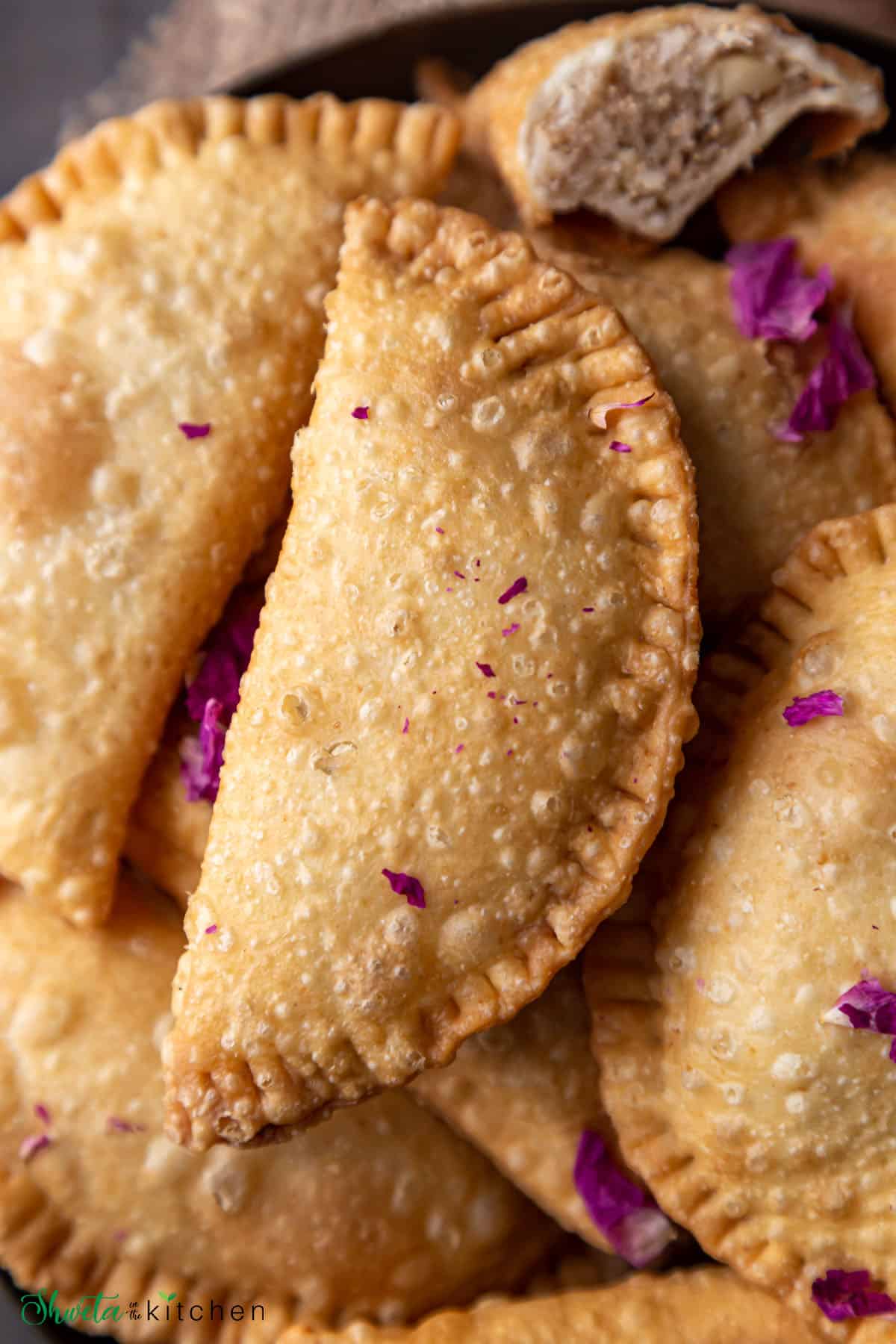
Maharashtrian Karanji
Karanji is a half-moon (semicircle) shaped sweet made with an outer covering of all-purpose flour and stuffed with a mixture of coconut, whole wheat flour (atta), poppy seeds (khuskhus), dry fruits (cashews and raisins), and flavored with cardamom.
It is deep-fried in ghee or oil to get that crispy karanji. This is such an important step since frying at the right temperature is crucial.
As mom says karanji should be khuskhushit, meaning the covering should be crisp and flaky and melt in the mouth which is the sign of well-made karanji.
The Karanji filling, also known as saran can be made using either dry coconut powder (desiccated coconut) or fresh (or frozen) coconut.
Fresh coconut karanji is also known as Olya naralachi karanji in Marathi. They taste so delicious but they have a short shelf life compared to the dry coconut filling ones.
Gujiya is the northern counterpart of Karanji. It is filled with mawa instead of coconut and is made mainly for the Holi festival. The overall process for Gujiya and even the shape is the same as karanji.
I'll share gujiya recipe sometime later, but today lets see how to make these Karanji recipe.
For More Diwali Recipes click here: Diwali Sweets and Savory Snacks
Recipe Ingredients
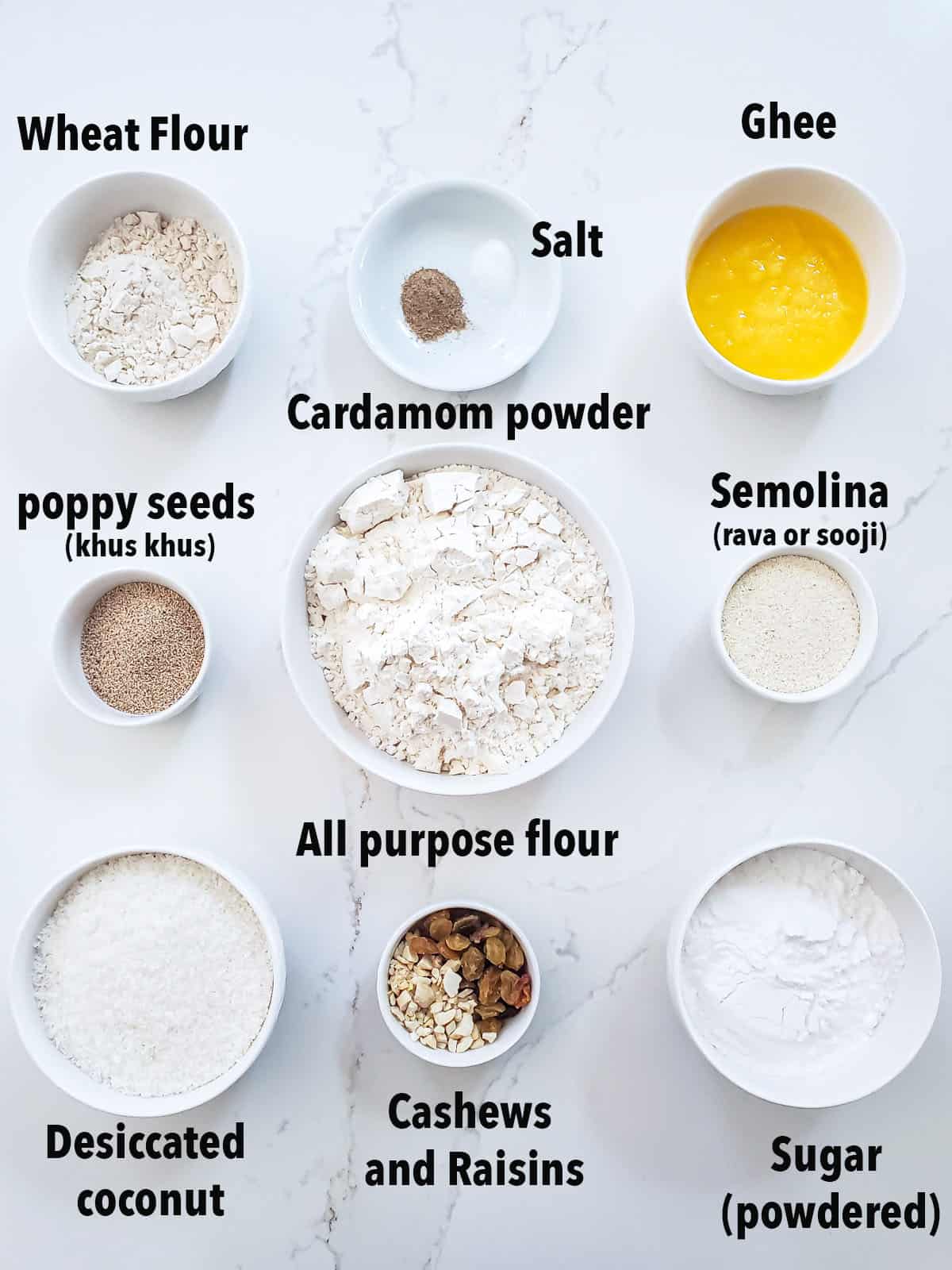
The filling (Saran) - dry desiccated coconut (powder) or fresh/frozen coconut, wheat flour, white granulated sugar, poppy seeds (khus khus), dry fruits (cashews and golden raisins), and cardamom powder for flavor.
The outer covering - all-purpose flour (maida), ghee, salt, semolina (rava or sooji) and water (or milk) for kneading.
For frying - Oil or ghee (preferred) or use a mix of both.
Step by Step Method
For the outer covering:
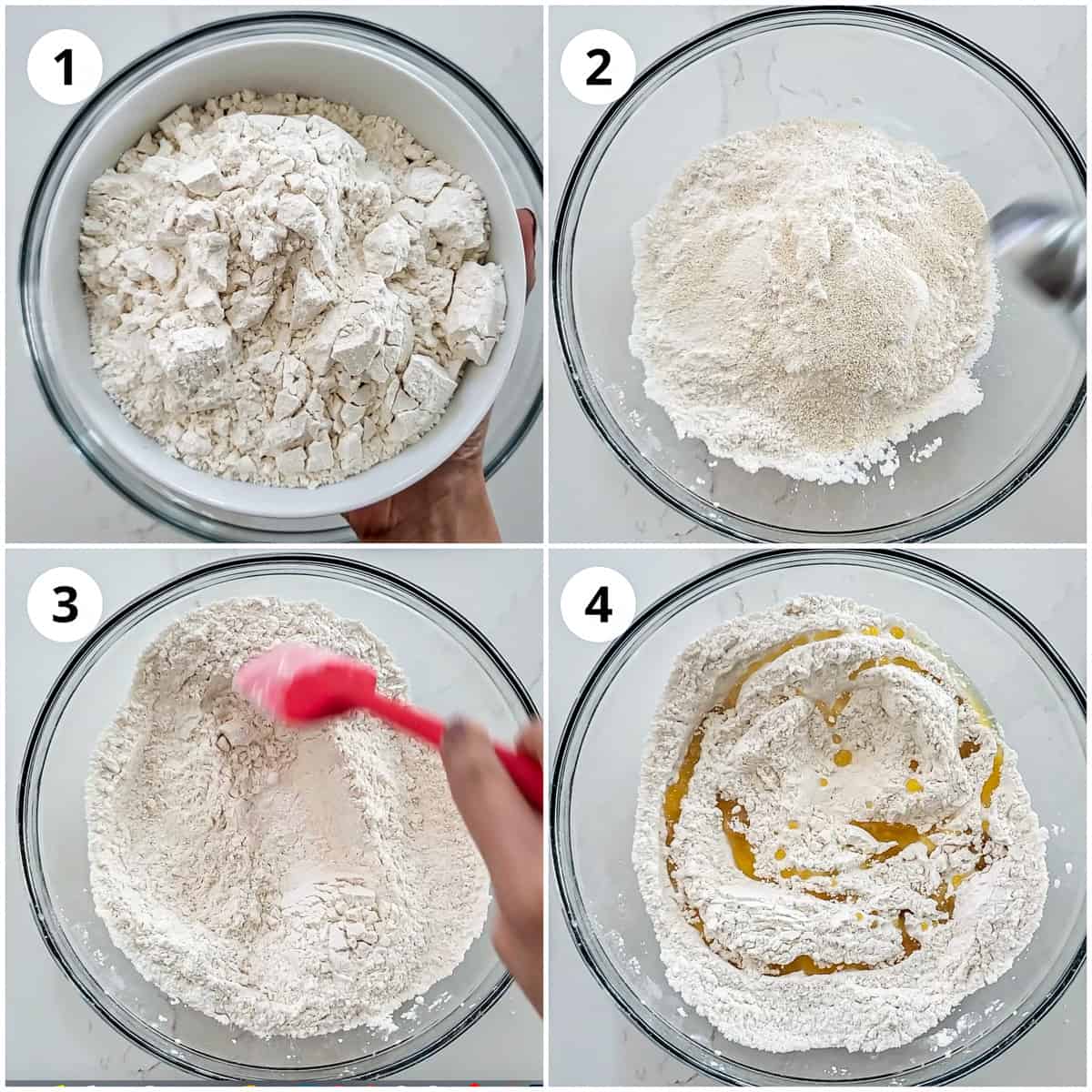
1 to 3 In a mixing bowl, add all-purpose flour (maida), salt, and semolina (rava or sooji). Give it a quick stir.
4 - Heat ghee on stovetop or microwave for 30 secs. Add the hot ghee to the flour mixture and mix so its evenly distributed in the flour mixture.
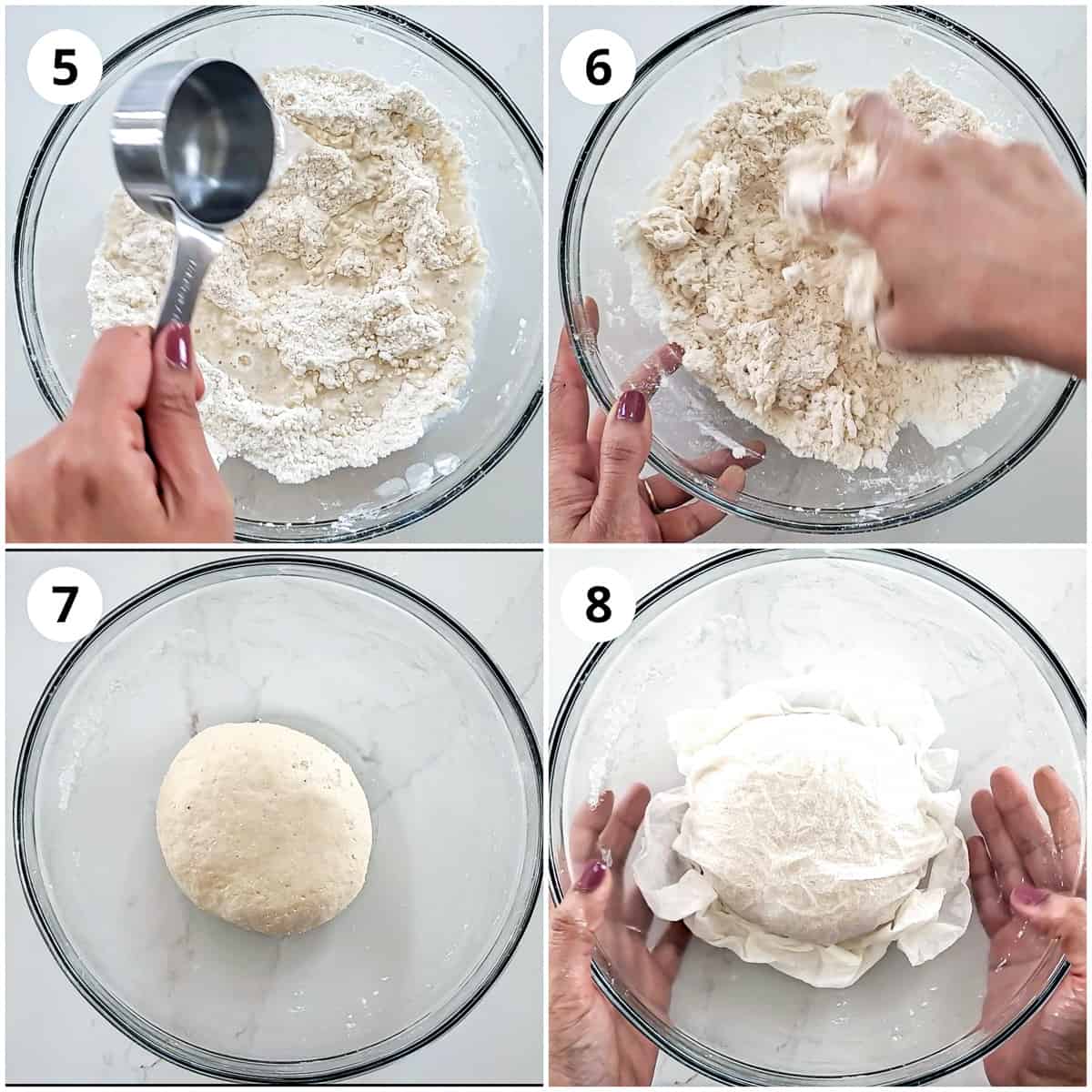
5 to 7 - Using water (or milk), knead into a firm (stiff) dough.
8 - Cover with wet cloth and keep aside for 15-20 mins.
While the dough is resting make the saran (coconut filling)
For the Dry Coconut Filling:
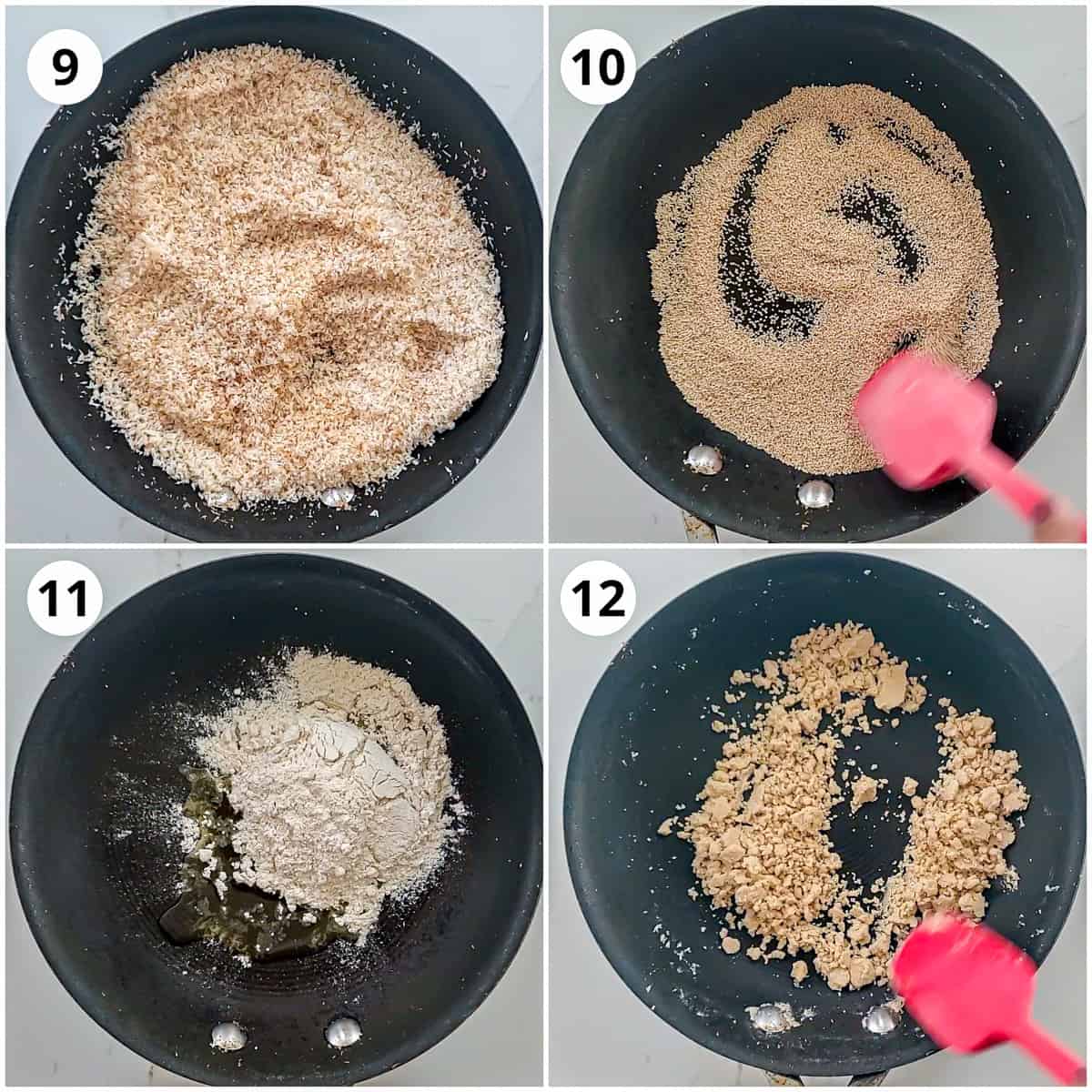
9 - Heat a frying pan on medium-low heat and roast the dry coconut powder until golden. Transfer to a bowl.
10 - Similarly, roast the khuskhus (poppy seeds) too and transfer them to the bowl with coconut.
11 and 12 - Add ghee and wheat flour to the bowl and roast until fragrant and golden. Keep stirring continuously to avoid burning the flour.
13 - Transfer the roasted wheat flour to the bowl too.
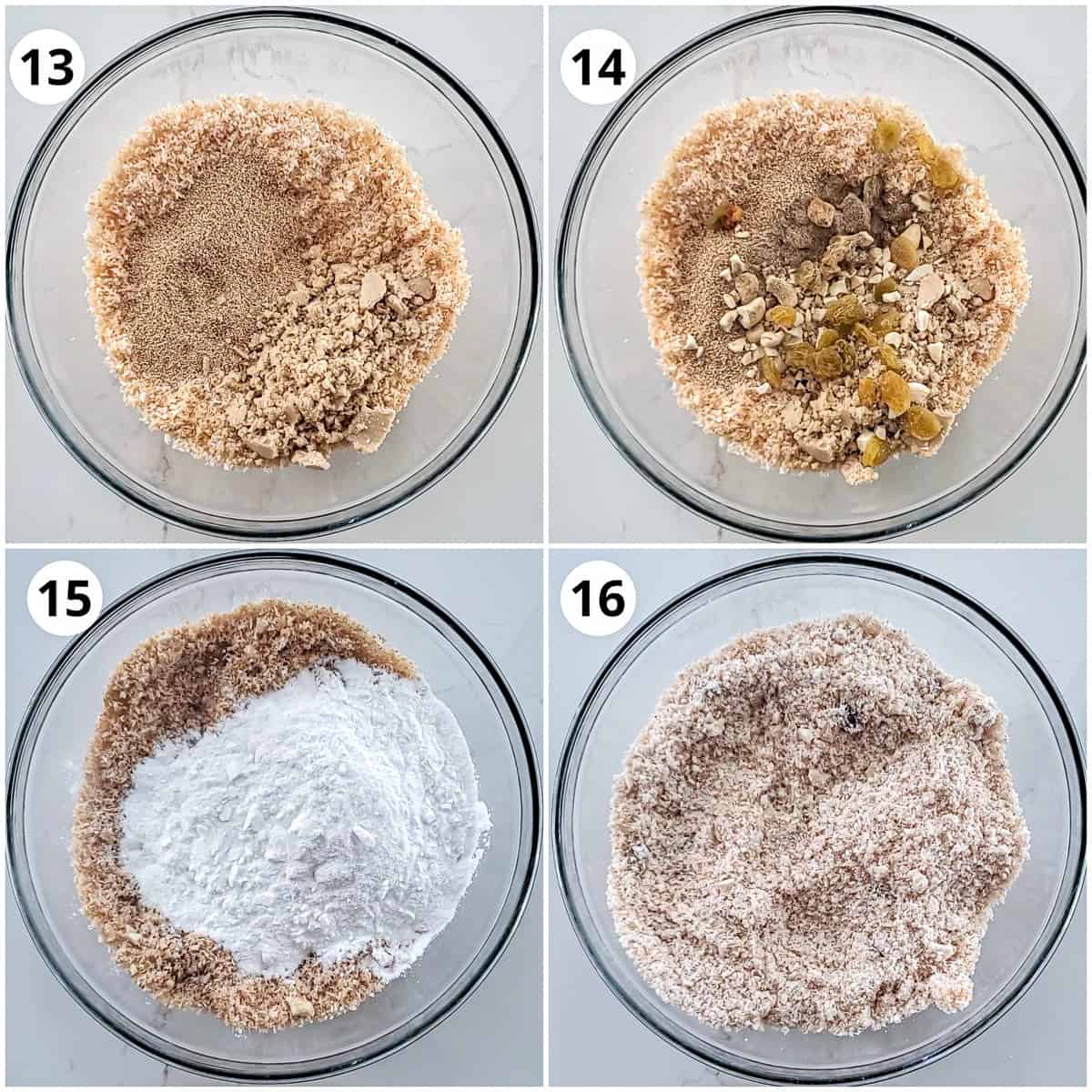
14 - Add cashews, raisins, and cardamom powder to the roasted coconut mixture. Allow too cool slightly.
15 and 16 - Add the powdered sugar and mix well. Filling is ready. Keep aside.
Note: Grind the sugar in a grinder to get a powdered texture.
This filling can be made ahead and store refrigerated until ready to use.
Similarly, you can make the filling using fresh or frozen coconut too.
To make the karanji (without mold)
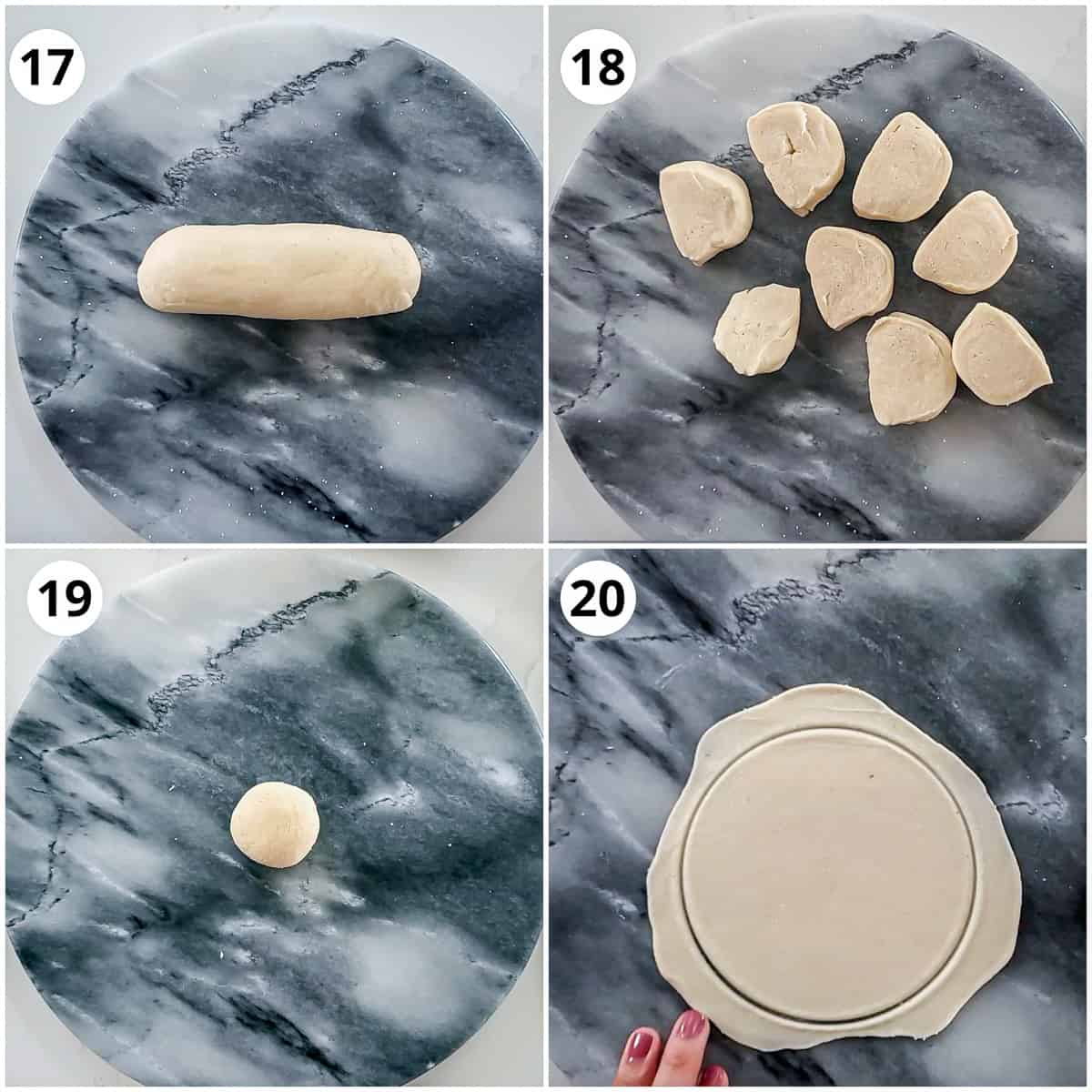
17 - Divide the rested dough into two parts. Roll each part into a log.
18 - Cut each log into 8 equal parts.
19 - Take one part and keep the remaining covered with a wet cloth. Roll it between your palms to make it smooth and round.
20 - With a rolling pin, roll the dough round in a 4 to 5 inches diameter circle (like a puri).
For those same sized karanjis, use a round pastry cutter or jar lid or Katori to cut the rolled dough round.
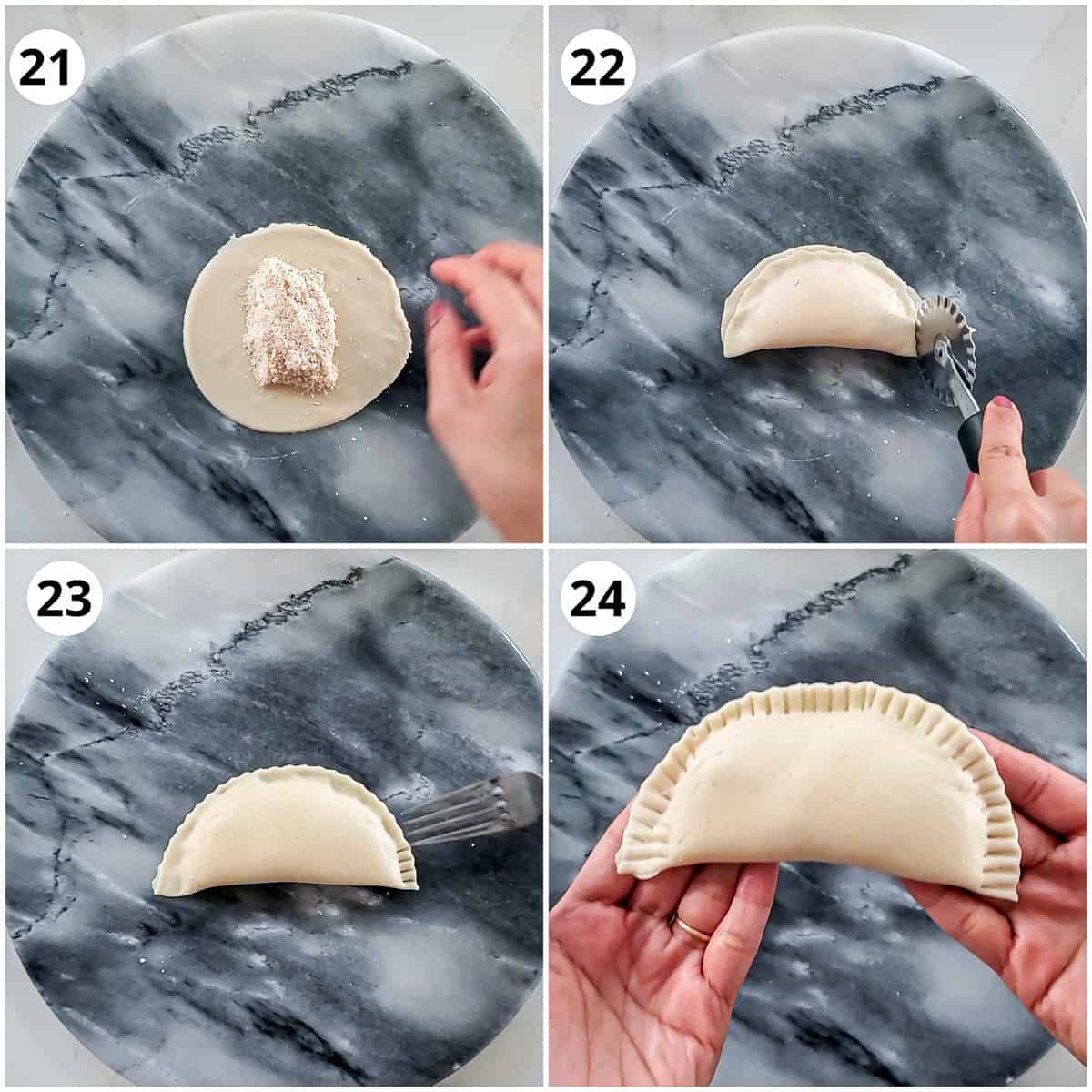
21 - Place a 1-2 tablespoon of the filling in the centre of the circle leaving the sides clear. Do not over stuff.
Apply a thin layer of water around the circumference of this rolled dough.
22 - Close & form a half-moon (semicircle) shape. Press the edges to seal.
If not sealed properly, it will open up while frying and make the oil messy.
Using a karanji cutter cut around the sealed dough area to form an even shape. These can be fried as is or to make some pattern do the next step.
23 - To make a pattern, press the edges using a fork.
24 - Place the karanji on a plate and cover with a wet cloth to prevent from drying. Make all karanjis this way and then fry them.
To make karanji using a mold, please see the video (in recipe card). I got mine from India. but was able to find the mold online.
For Frying
Line a plate or baking tray with tissue paper and keep it ready.
Heat oil (or ghee or a mix of both) in a frypan on medium heat.
Test the oil by dropping a small portion of the dough. It should sizzle right back up without quickly browning.
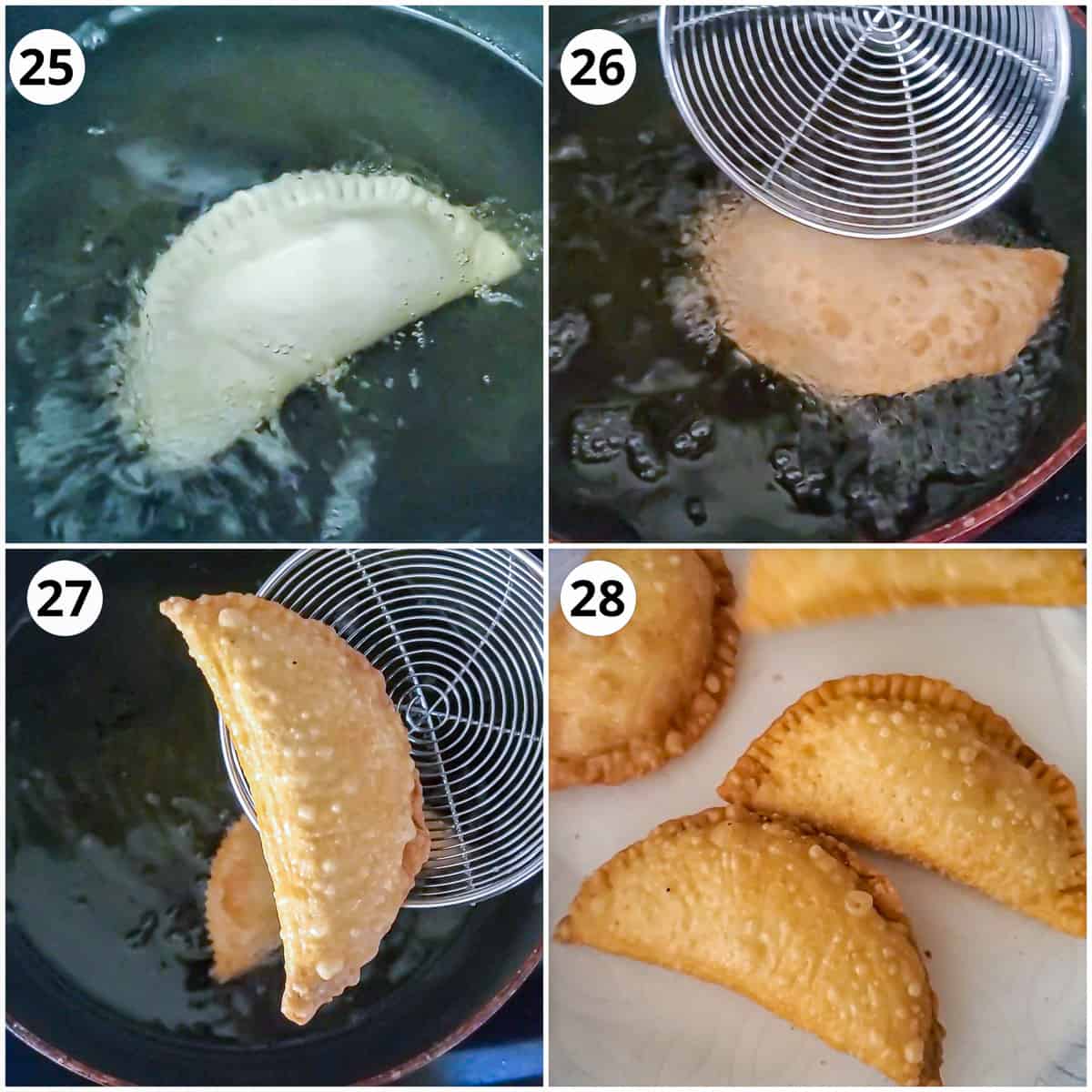
25 - Once the oil is hot, slide 1-2 karanji into the oil. Do not overcrowd.
26 - Fry one side and then flip when golden. Similarly fry the other side too until golden and crisp. The karanji will puff while frying.
27 and 28 - Drain using a slotted spatula and then transfer to the lined plate for drain excess oil.
Serve warm or room temperature. Cool completely and store airtight.
Crisp, flaky & sweet coconut Karanji is ready, enjoy them as dessert or snacks with your tea!
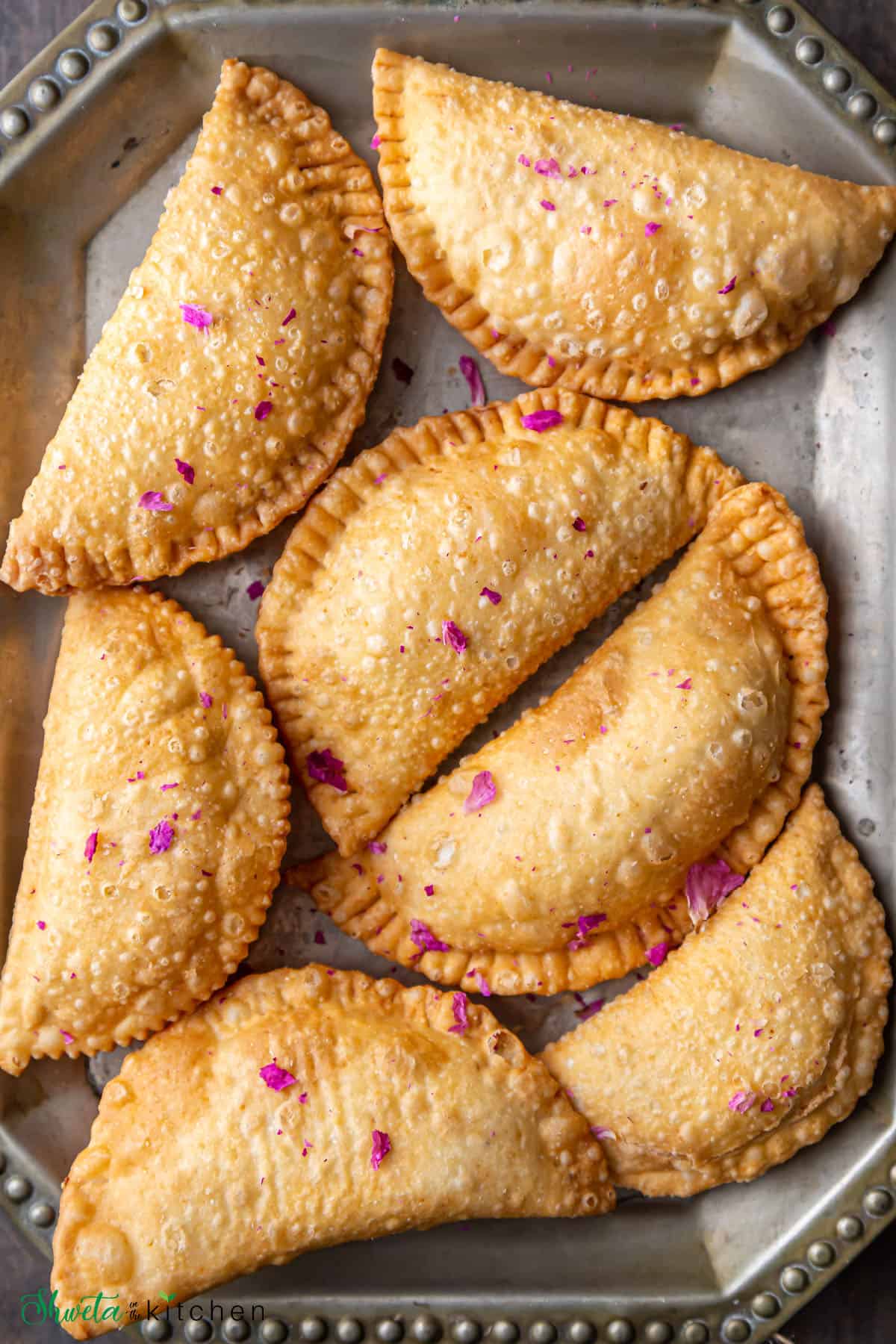
Storage
Allow karanjis to cool completely and then store airtight at room temperature. They can easily last for 3-4 weeks. But bet these will be over way before!
Tips for the crispy outer layer
- Add bubbling hot ghee to the flour and incorporate it into the flour before adding water. This helps in making the cover flaky (khuskhushit).
- Use minimal water to make the dough. The dough should be stiff and firm. A softer dough will make the covering soft on frying and absorb more oil.
- Fry on at the right temperature and medium heat. Very hot oil will cause them to brown quickly leaving the inside soft and uncooked and too low heat will cause them to turn soft.
Other tips and notes
- Roast coconut, wheat flour, and poppy seeds for that nutty flavor.
- Rest the dough. Helps relax the gluten and makes rolling easier.
- Grind the sugar in a grinder to get a powdered texture. Keep aside.
- Keep the dough and the filled karanjis covered at all times to prevent drying.
- Seal the karanji well, otherwise, the filling will spill out while frying making the oil muddy. If this is to happen, filter the oil to remove the particles and then start frying again. Be careful while handling hot oil.
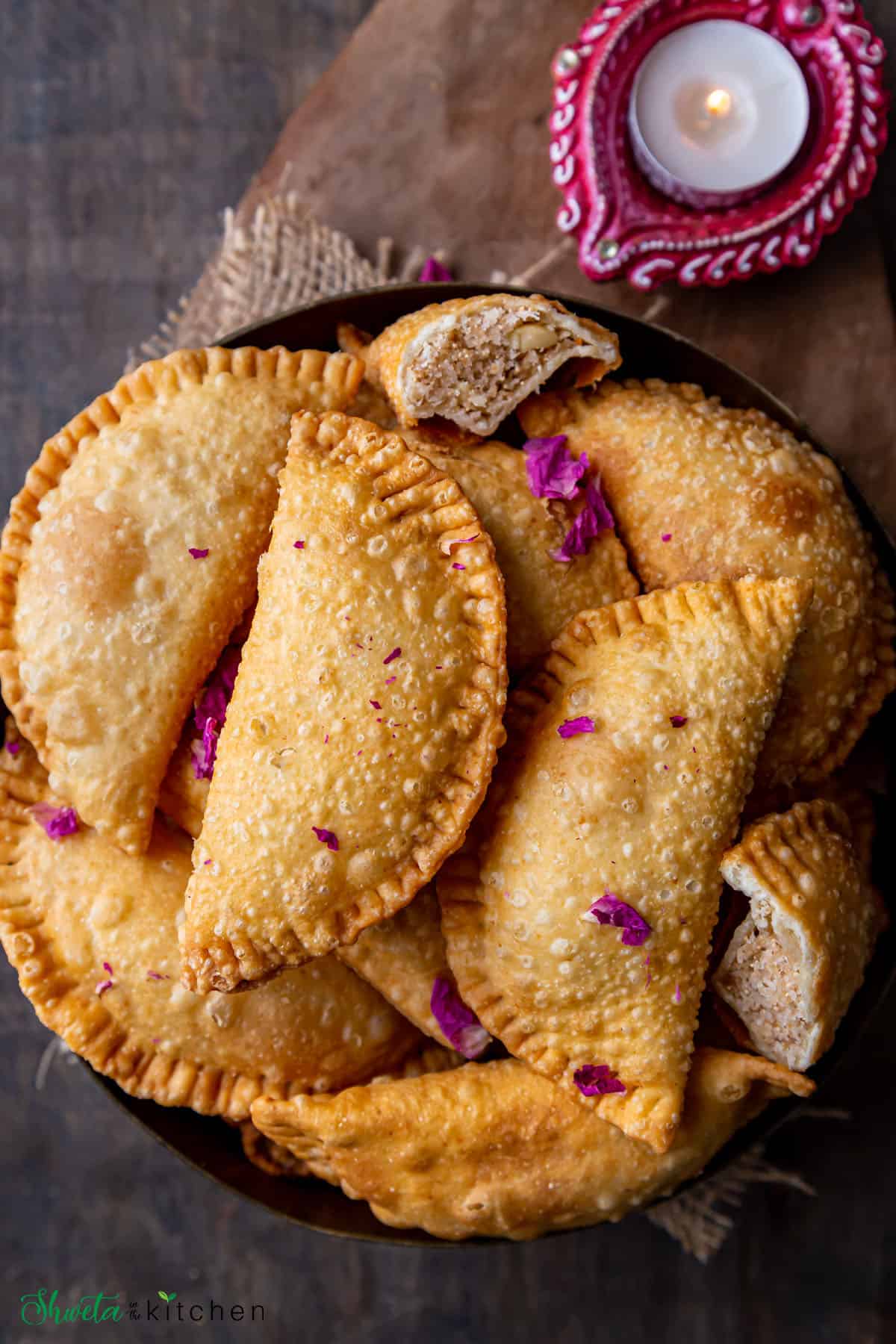
Frequently Asked Questions
Yes, you can make the dough using all wheat flour. 50:50 of wheat flour and all-purpose flour can also be used. Note that you will need more water when kneading the dough using wheat flour and also the texture of karanji on frying will be different than the all-purpose flour one. For best texture, use all-purpose flour.
Yes, you can bake the karanji in the oven. Place them on a parchment-lined baking sheet, spray some oil and bake in a preheated oven at 400°F for 15-20 minutes or until golden and crispy. Let them cool on sheet for 5 minutes before serving.
Yes, place the uncooked karanji in the fryer basket, spray some oil and bake at 370°F for 10-12 mins, rotating half way through. Serve immediately.
More festival recipes
Hope you enjoy this Karanji recipe!! If you give this recipe a try, please rate by clicking stars ⭐️ in the recipe card. Thank you ❤️ ! You can also follow me on Facebook | Instagram to see what’s cooking in my kitchen!!
Recipe Card
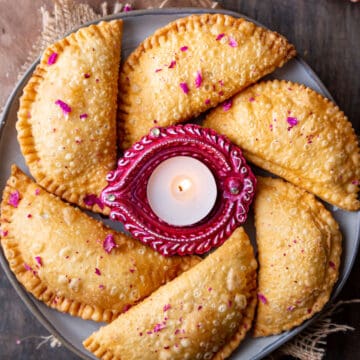
Karanji
Ingredients
For the outer covering:
For the Filling (Saran)
- 1 cup dry coconut powder
- 2 tablespoon poppy seeds khuskhus
- ½ tablespoon ghee
- ¼ cup wheat flour
- ¾ cup powdered sugar pithi sakhar, adjust to taste
- ¼ teaspoon cardamom powder
- 10 cashews roughly chopped
- 2 tablespoon golden raisins
Instructions
For the outer covering:
- In a mixing bowl, add all-purpose flour (maida), salt, and semolina (rava or sooji). Give it a quick stir.
- Heat ghee on stovetop or microwave for 30 secs. Add the hot ghee to the flour mixture and mix so it's evenly distributed in the flour mixture.
- Using water (or milk), knead into a firm (stiff) dough.
- Cover with a wet cloth and keep aside for 15-20 mins.
- While the dough is resting make the saran (coconut filling)
For making the filling (saran):
- Heat a frying pan on medium-low heat and roast the dry coconut powder until golden. Transfer to a bowl.
- Similarly, roast the khuskhus (poppy seeds) too and transfer them to the bowl with coconut.
- Add ghee and wheat flour to the loan and fry until fragrant and golden. Keep stirring continuously to avoid burning the flour.
- Transfer the roasted wheat flour to the bowl too.
- Add cashews, raisins, and cardamom powder to the roasted coconut mixture. Allow too cool slightly.
- Add the sugar and mix well. The filling (saran) is ready. Keep aside.
- This filling can be made ahead and stored refrigerated until ready to use.
To make karanji (shape and fill)
- Divide the rested dough into two parts. Roll each part into a log. Cut each log into 8 equal parts.
- Take one part and keep the remaining covered with a wet cloth. Roll it between your palms to make it smooth and round.
- With a rolling pin, roll the dough round in a 4 to 5 inches diameter circle (like a puri).
- For those same sized karanjis, use a round pastry cutter or jar lid or Katori to cut the rolled dough round.
- Place a 1-2 tablespoon of the filling in the center of the circle leaving the sides clear. Do not over stuff.
- Apply a thin layer of water around the circumference of this rolled dough.
- Close & form a half-moon (semicircle) shape. Press the edges to seal completely. If not sealed properly, it will open up while frying and make the oil messy.
- Using a karanji cutter cut around the sealed dough area to form an even shape. These can be fried as is or to make some patterns do the next step.
- To make a pattern, press the edges using a fork.
- Place the karanji on a plate and cover with a wet cloth to prevent from drying. Make all karanjis this way and then fry them.
For frying:
- Line a plate or baking tray with tissue paper and keep it ready.
- Heat oil (or ghee or a mix of both) in a frypan on medium heat.Test the oil by dropping a small portion of the dough. It should sizzle right back up without quickly browning.
- Once the oil is hot, slide 1-2 karanji into the oil. Do not overcrowd.
- Fry one side and then flip when golden. Similarly, fry the other side too until golden and crisp. The karanji will puff while frying.
- Drain using a slotted spatula and then transfer to the lined plate to drain excess oil.
- Serve warm or room temperature. Cool completely and store airtight.
- Crisp, flaky & sweet coconut Karanji is ready, enjoy them as dessert or snacks with your tea!
Video
Notes
- Add bubbling hot ghee to the flour and incorporate it into the flour before adding water. This helps in making the cover flaky (khuskhushit).
- Use minimal water to make the dough. The dough should be stiff and firm. A softer dough will make the covering soft on frying and absorb more oil.
- Fry on at the right temperature and medium heat. Very hot oil will cause them to brown quickly leaving the inside soft and uncooked and too low heat will cause them to turn soft.
- Place uncooked karanji on a parchment-lined baking sheet, spray some oil and bake in a preheated oven at 400°F for 15-20 minutes or until golden and crispy. Let them cool on sheet for 5 minutes before serving.
- Place the uncooked karanji in the fryer basket, spray some oil, and bake at 370°F for 10-12 mins, rotating halfway through until golden and crisp. Serve immediately.



Perfectly shaped karanjis..perfect sweet snack on every occasion..!:)
really looks so tempting
We call these ghughara!! Usually make them for Diwali. I love these but never got round to making them this year.
looks so beautiful Shweta! 🙂 Perfect Diwali snack!
Prefect gujiyas, beautifully done.
Hmm, I like the look and the smell of it. (Yes, I can imagine the smell!)
Karanji looks delicious and crispy. Love it.
wow..very nicely done,love it too:)
Join my ongoing EP events-Asafoetida OR Fennel seeds @ Divya's Culinary Journey
came out perfect:)
Grand Giveaway at sirisfood.com-Win exciting prizes
Looks so yum ...nicely done
gujiyas are my fav.. i like all kind of stuffings..
yummy looking karanji...
Looks so tempting and mouthwatering....